
| 
|

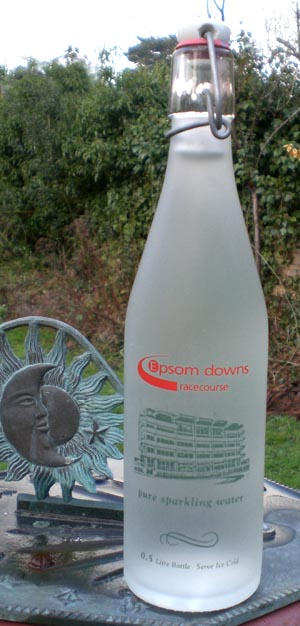 EPSOM AND EWELL WELLS - Chapter 15
EPSOM AND EWELL WELLS - Chapter 15Placing the Demise in a Scholarly Context
Dr Bruce E Osborne
Placing the Demise in a Scholarly Context - understanding the rise and fall of Epsom Spa and Wells.
15.1. Horse Racing and water reincarnate - local water botttled for the grandstand at Epsom, early 21st century.
Whilst it is in human nature to look for a scapegoat to blame for the demise of Epsom, it is important to understand the demise in a broader context. Epsom was one of a number of spas that flourished from the 1600s onward and each had its own characteristics and life cycle. Andrews' map of 1797 identifies in excess of 200 spa resorts in England and Wales.[1] At the end of the 1990s it was possible to count the active spas of England on the fingers of one hand. The 21st century saw a dramatic world wide expansion of the spa industry. It can be seen that resorts have emerged, flourished and declined. Each life cycle is influenced by both factors within the resort and external circumstances. With Epsom it is possible to detect short periods of stagnation followed by periods of dynamic growth. What processes were influencing these cycles in prosperity and how does this enable the scholar to reinterpret what happened to Epsom? Does the analysis of resort life cycles also enable us to predict the options for the future? The 21st century redevelopment of Epsom's Waterloo House, the oldest surviving Assembly Rooms in the UK, inevitably raises questions of the future for Epsom’s spa heritage.
Health resorts traditionally consist of seaside and spa resorts and share the common origins by combining health treatments and leisure facilities into an holistic programme for the well being of visitors. In the past such programmes have been source water based but in recent years this aspects has taken a less prominent role in the marketing of the venue and its services. Health resorts world wide continue to be major visitor destinations and therefore play a significant role in tourism. Some health resorts are still functioning as seaside resorts or spas but others are living off their past by using artefacts as heritage attractions; others have failed to survive at all.
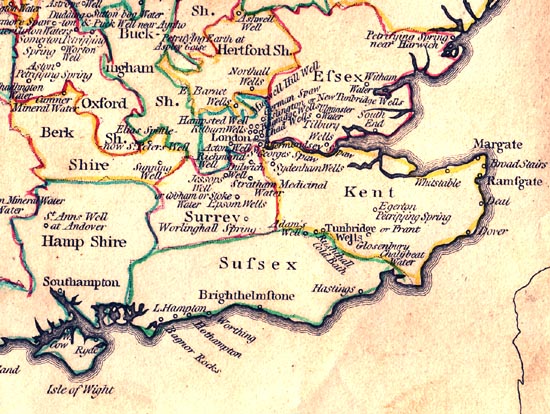
15.2. The south eastern section of Andrews 1797 map of mineral waters and bathing places in England and Wales.
In this chapter it is argued that the evolution, planning, and marketing of health and leisure resorts such as Epsom was once, will be better served by a clearer understanding of the stages of the development cycle through which they pass. The underlying assumption is that destinations, like any other product have a life cycle. The generally accepted idea is that there are stages of growth to the point where the product matures. Then it goes into decline as the consumer proposition becomes less relevant to the ever evolving market place. The destination life cycle is essentially a means of modelling the progressive growth of a locality and then considering alternative scenarios when the destination goes into decline. Numbers of visitors are often used as the key measure of destination growth and decline however this inevitably runs into difficulties because of the lack of data and the need to set precise boundaries to determine stages in the growth pattern. The value of the debate about such modelling is that it gives a descriptive framework for the evolutionary stages of a destination although the temptation is to attempt to use the model as the architect of the marketing strategy. The debate has attracted many scholars particularly in the fields of tourism, geography and history.
The research methodology adopted is to examine ways of improving the value of life cycle model theory for tourism destinations by addressing three ideas that have been identified as problematic by previous work. These are; the role of the model, the way that decline and regeneration is considered and destination generalisation versus specialisation. In this chapter, the tactic is to develop a classification of stages in the development of resorts that are rather more sophisticated than existing ones. Health resorts are used as the exemplar and in particular, the model is modified to see whether narrowing down to this specific type of destination improves the value of the model as an investigative tool.
Since 1980, when Butler took the product life cycle and applied it to destinations, there has been extensive exchange between scholars about the viability and merits of establishing a life cycle model.[2] More recently Agarwal (1997) tested the empirical evaluation of such a model using Torbay as a case study.[3]This study noted that the notion of a conceptual model was acceptable as the basis for generalised theory however the on-going process of rejuvenation that she identified in her case study did not fit Butler's model. Agarwal suggests that the post-stagnation stage needed revising in the light of the Torbay study and attempts to rejuvenate the tourist proposition. This implies that Butler's consistent rising curve with a number of options after the stagnation stage needed rethinking in order to make it more applicable. Getz (1992) also had difficulty in reconciling the experience of Niagara Falls with the later stages of the life cycle model.[4] He proposed that a permanent state of maturity is achieved with consolidation, stagnation, decline and rejuvenation interwoven.
Other commentators on the operational value of life cycle modelling include Haywood (1986).[5] Haywood reiterates concern that the general life cycle model could cause inappropriate responses from tourism planners with the onset of a decline stage. The discussion is mainly marketing orientated and indicates that the model fails as a development tool, instead a Darwinian 'survival of the fittest' approach is advocated to resort survival. On the other hand Ioannides (1992) in a case study evaluation based on Cyprus is able to match the growth of tourism with the Butler model.[6] He bemoans however the failure of the model to give prescriptive powers for forming future strategies and goes on to advocate an integrative framework to cope with improving understanding. This appears to have similarities to the problem highlighted by Haywood in that the model fails to give a clear answer as to what actions are necessary to secure a rejuvenation in the later stages of resort development.
It would be possible to considerably extend the summation of earlier work however the cited research papers identify two key issues that need addressing to improve the usefulness of the Life Cycle Model. The two issues are:
First the dissonance between the model and reality, particularly in the later stages of the life cycle,
And
Secondly whether the model can be used to steer the development of effective marketing and strategic plans in order to avoid stagnation and decline.
Another consideration is the relevance of a general model to resolving issues relating to a specific resort.
It will be demonstrated that a new approach to the model has the potential to resolve these problems and throw new light on the demise of such spa resorts as Epsom. This builds on a working paper presented at the European Tourism Conference at Madeira (1999) that started to address these ideas.[7]
The purpose
The first idea to clarify is what is the purpose of such a model? If it is intended to provide a detailed development programme that enables a resort to avoid unfavourable circumstances such as stagnation and decline, then this notion is likely to be unsustainable. The model is not an oracle capable of determining the marketing and development plan. It is an indicator of circumstances and what is sought from the model must be reconciled against its realistic potential and role as a management tool.
What are we seeking from such a model?
1. To understand the historical and present evolutionary characteristics of a resort; this will include the nature and scale of facilities and their impact. Such analysis would be based on an inventory of facilities and tourism impact, both historical and present day. The model provides an understanding of the key characteristics that are present at different evolutionary stages as well as an appreciation of the present life cycle stage of a resort.
2. To explore possible future scenarios by anticipating future evolutionary characteristics; the model thus becomes a predictive tool. The model suggests what a resort might be like if the location progresses to another developmental stage. The model indicates the likely characteristics of the next stage and so may provide an early warning system for recognising symptoms and a framework for addressing them. The characteristics should be considered in the context of a marketing or development plan therefore and the plan adjusted accordingly.
3. To determine what causes divergence from the model as a means of understanding anomalies in the resort and its evolution. From the historical perspective, if the resort has not exhibited the typical characteristics of the model then the reasons for that non-conformity need to be considered. This in turn enables plans to be adjusted accordingly.
It can be argued therefore that earlier scholarly debate about the application of a model to the preparation of the detailed marketing or development plan was over optimistic. The model does however provide a vision of the future. In other words, the life cycle model assists in the plan formulation but does not spell out the plan itself.
Decline and regeneration
The next idea to be addressed is the problem of resolving the debate about the reconciling of latter stages of the life cycle, particularly the problem of regeneration. Here it is now argued that refurbishment and regeneration of the consumer proposition are events that necessarily take place spasmodically throughout a resort's life cycle. It is argued that a resort moves forward in a series of steps as opposed to a more regular growth pattern in Butler's early model. Each step is an uplift or improvement in the facilities available and is offset by a continuous process of decline in the resort infrastructure and proposition. The incremental growth pattern with ensuing decline addresses the Darwinian approach advocated by Haywood in that the resort has to refurbish its proposition otherwise it looses ground in an ever-competitive market as well as suffering natural physical infrastructure decay.
As a result Butler's smooth curve of growth is questioned. What appears to happen is that growth comes through a series of increments. After each increment decay ensues until the next increment is implemented. If the next increment of growth is implemented within a short time scale then this is considered refurbishment and positive development. If however circumstances prevail that the next increment of growth is not implemented or is unduly delayed, stagnation and decay will ensue regardless of the developmental stage that the resort has earlier reached. Reasons for delaying the incremental growth will vary between locations and will be closely tied to the availability of capital investment funding, market competition, etc. A trigger to embarking on the next growth stage will be reducing returns on earlier capital investment in an historic environment of rewards and dependency on the health resort proposition. When this undue delay occurs, the decline may be so far advanced that the resort in effect embarks on a new life cycle. Butler’s overall smooth curve therefore prevails only if continuous growth in an ideal world is experienced. To adapt it to real life fluctuations in development means that there are a series of steps each followed by decline.
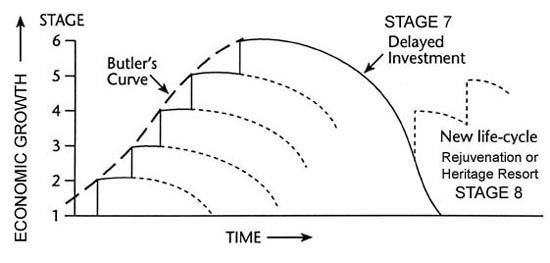
15.3.Incremental growth curve for Health Resorts.
Generalisation v. specialisation
The final idea to be addressed is one of generalisation. Butler produced a general model for all tourist resorts and to do this had to take a non-specific viewpoint to ensure that the model could encompass the majority of tourism venues. A general model will give general results. These may be insufficiently focused for the model to perform well in the roles set out in 1 - 3 above. In addition different tourism locations are likely to perform in manners that mean that the basic model has a large degree of divergence and looses relevance for many applications. To overcome this it is necessary to produce a specialist model that is customised to a particular type of tourism location or product sector.
This chapter now seeks to explore this approach further with Health Resorts, both spas and seaside locations in order to test the notion that an adapted model has better prospects of achieving higher quality outcomes. Spa and Seaside resorts prosper world wide and have proved sustainable over long periods of time. This does however raise a further question – is it possible to refine a model that would be equally valid for both types of resort?
Osborne first mooted the idea of a model for spas at the British Spas Federation/University of Sussex annual Spas Seminar in October 1997 at the University of Sussex. Berry on the other hand was independently working on similar ideas for seaside resorts.[8] Since then detailed casework has enabled the initial ideas to be refined and merged.
Further Refining the model
A key aspect of refining the model comprised an evaluation of the indicators used to determine the stages in the life cycle model. Investigating Health Resorts prompted the identification of a number of indicators specifically pertinent to this type of resort, for example "medical credibility” and leisure facilities encapsulated in "consumer proposition”. These are not broad general conceptual frameworks, but precise indicators which seek to avoid undue overlap with each other where possible, and which characterise the underlying process of change that is proceeding.
In addition however it was considered necessary to incorporate a number of general indicators. This potentially risked the model becoming too generalised but it was felt that this was offset by two considerations. Firstly the safeguard to ensure that adequate indicators were available to make the model comprehensive and secondly that these general indicators provided an insurance against inadequate information availability for the analysis of the other indicators.
Another issue that was addressed in the selection of indicators was that as far as possible they should be free from temporal constraints that would make historic comparisons over different time scales difficult if not impossible. By using indicators that are potentially timeless, general scientific and technical innovation becomes an overlay with the fundamental indicators providing the timeless foundation for the model. This overcomes the problems of comparison across different time spans.
As a result nine parameters or indicators have been selected: Medical Credibility, Marketing and Promotion, Consumer Proposition, Chargeable Service, Land, Transport and Communications, User Profile, Entrepreneurs and Capital Deployment. These in turn were examined to identify changes in the characteristics of each during the life cycle of a health resort. Six distinct progressive developmental stages are evident, each with their own distinct characteristics. These cover the evolution from a natural landscape or a non-specific settlement through to a world class resort. Each stage reflects a significant expansion in resort facilities in line with the incremental growth concept outlined earlier.
In addition a 7th, Declining Resort stage is identified as a resort goes into stagnation and decline and three options thereafter ranging from defunct through to rejuvenated. This 7th stage can become operational at any time in the resorts' life cycle and is not necessarily sequential therefore. It comes about as a result of delaying refurbishment and other capital investment that means that the resort is ceasing to function effectively. Accepting that this stage can appear at any time in the life cycle overcomes the problems of Butler's later stages as identified previously.
Underlying the explanation of resort rejuvenation is the belief that resorts can and do re-embark on new life cycles following extended decline, in effect reverting to earlier evolutionary stages. This notion gives rise to the belief that there are two alternatives which enable the Health Resort to effectively remain within the industry. These are the two 8th stages, heritage or rejuvenated resort, and they can become effective following the extended decline from any of the previous growth stages. There are other alternatives. The resort may develop in other directions, away from the general classification of Health Resort in which case it drops out of the industry and this specific model no longer applies. At this point the location goes into total dysfunction as a Health Resort and the 9th stage applies.
Whilst inevitably tourist numbers would help with the analysis of each stage they are by no means a precise determinate and reliable historic figures are rarely available. The same point applies to other data such as how much is invested in facilities. The alternative approach taken is to base each stage on qualitative characteristics. This requires a degree of judgement on the part of the user and leads to the belief that experience in applying the life cycle model aids its interpretation.
A final consideration in refining the model was the relevance of Butler’s logistic curve. Whilst it is seen as a general underlying pattern it has already been argued that the incremental growth concept disturbs the free flow of Butler's curve. Nevertheless Butler's logistic curve prevails as an underlying general concept. Initial development, fuelled by a percentage of resort "gross domestic product", would initially be small and growth slow. As revenues increased so would further investment in development and the growth would accelerate. As the resort reached market optimisation however the investment in development would be subject to the law of diminishing returns and growth would inevitably slow. The choice of a logistic curve therefore is justified, such a curve having similar application in other industries.[9]
Applying the Life Cycle model to give a clearer understanding of the demise of Epsom Spa
Epsom as a spa emerged in the latter part of the 16th century. Compared with other major UK spas its life cycle was short. By the 1750s Epsom was struggling to maintain any resemblance of a spa resort and was defunct well before the end of the century. In spite of this Epsom was one of the most celebrated spas when at its zenith. Such was the fame of its mineral water salts that it gave its name to a medicine that became world-renowned. Using Epsom as a case study to test the Life Cycle Model is valuable because its resort time span covers a period earlier than any other major UK spa. In addition research into the history of Epsom suggests that growth was not consistent but intermittent, for example the 1680s appear to have been a period of stagnation and possible decline. The Life Cycle model assists in clarifying how the process of growth progressed in a series of intermittent development stages.
It can be argued that early balnea development first took place at nearby Ewell with the development of Nonsuch Palace by Henry VIII (reigned 1509-1547) where the King built a balnea. It was Henry’s daughter Elizabeth I who saw Epsom in the earliest stages of its evolution. As a Simple spa it is recorded that a pond on the common became noted for its ability to cure ulcers and other ailments. Physicians who visited the site in 1603 identified bitter purging salts in the waters. Legend has it that a Henry Wicker, by experimentation, researched the efficacy of the "aluma" or "alum" waters. By 1620 country people were using the waters both internally and externally suggesting word of mouth communication of the healing properties at what is identified in the illustrated model as the Primitive stage.
The establishment of a Minor Resort came about shortly afterwards with a Dutch visitor recorded in 1629 and Lord North bringing the wells to the attention of the court circa 1630. Epsom Wells soon enjoyed the patronage of Maria de Medici and other notables and it can be concluded that facilities were developing in the nearby town of Epsom to support such tourism.
By the 1650s it is apparent that Epsom was entering the Significant Resort stage with details of visits to the wells recorded by Dorothy Osborne and Sir William Temple. Also at this time John Aubrey, the great historian, carried out experiments with the Epsom waters. The dissolution of Parliament in 1654 appears to have had only a minor effect on the progress of the spa. With the restoration of the monarchy Epsom continued as a Significant Resort offering a wide range of services. The lord of the manor was instrumental in building a pump room facility on the common. When Samuel Pepys arrived in 1663 he found the town full. On another visit in the same decade he noted Nell Gwyn lodging next door with Lord Buckurst. She was later to become the mistress of Charles II. It is apparent that Epsom was a regular haunt of the affluent and powerful from London and that the entertainment and facilities were of a standard to maintain such patronage. On the common, Richard Evelyn, lord of the manor carried out numerous improvements at The Wells, only to die in 1670 of what was believed to be at the time, an overdose of Epsom Salts. In spite of this, medical endorsement came in the form of Boyle and Grew who sought to identify the bitter purging salts.
The events outlined in the previous paragraph established the pattern for the next 40 years during which some stagnation and even decline are suggested. This was until a John Livingstone moved to Epsom towards the turn of the century. He acquired land in the town and proceeded to develop a New Wells in competition to the Old Wells out on the common. Contemporaneously John Parkhurst, as new lord of the manor that he inherited from the Evelyn estate, carried out extensive improvements and investments within the town and at the Old Wells. This investment programme launched Epsom into a period as a Major Resort. When Celia Fiennes visited Epsom in 1712 she recorded an Epsom vastly different and improved from the time of her earlier visit in the early 1690s. She found shops and a long room at the Old Wells. The New Wells were prospering in the town under the management of Livingstone. There were bowling greens, gaming and dance rooms, taverns and eating-places. The New Tavern, erected in 1692, was the largest in England. This in turn attracted extensive patronage from all classes, including the court, and it should be considered that Epsom became a World Class Resort for a few years.
Livingstone's death in 1727 is the turning point in Epsom's fortunes. Daniel Defoe's earlier publications circa 1720s promote Epsom as a resort but by 1738 the text had been altered to reflect the decline. The quality not only of the facilities but also the company available deteriorated and the Abbe Provost observed that Epsom was the place for young men to take a course on profligacy. The fashionable had left for elsewhere. Competition was coming from other spas, particularly Tunbridge Wells nearby. In addition the artificial manufacture of Epsom Salts reduced the need to take the waters direct and problems of purity cast a shadow on Epsom's reputation for medical efficacy. Here we have the classic case of spa demise, the medical credibility wavered and there was a prolonged period when capital investment in the spa development was missing. The longer the ensuing decline the greater the resources needed to arrest it. This all happened at a time when the industry elsewhere was becoming better organised and the consumer proposition at places like Tunbridge and Bath was being enhanced.
As the 18th century progressed the run down facilities at Epsom and the inevitable apportioning of blame for the demise were apparent. The Ambulator (1782) discussed the run down hall, galleries and public apartments. The Old Wells were run by a countryman and his wife who still did a modest business in selling bottled water but by and large Epsom was finished as a spa resort. The Defunct Resort stage in the life cycle is confirmed by the disposal of the Old Wells in 1770 when the estate of late John Parkhurst was auctioned. The Old Wells were untenanted at the time. Soon after, in 1775 the buildings of the New Wells were sold off for redevelopment.
Epsom thereafter prospered not as a resort but as a suburb town of London and as a result of its horse racing. Apart from a short lived flutter with bottled water in the early 2000s, it never went into a rejuvenation stage as a spa and although the town still has many buildings dating from its spa era, it has not pursued any ambition as a Heritage Resort.
Conclusion
The Resort Life Cycle works well when reviewing the evolution of Epsom spas compared with other resorts considered elsewhere. This suggests that the model works regardless of the temporal considerations. The indicators need to be adjusted to accommodate the technology and character of the age but nevertheless, having done so there is a clear pattern of developmental stages in Epsom interspersed with minor periods of stagnation.
As a result of testing the revisions to the model on Epsom and other Health Resorts, the conclusion is that the revised model is a valid means of studying life cycles. Within the various resorts tested it is believed that spas and seaside resorts have similar application to it. The adaptations used also resolve the problems identified earlier of the dissonance between the model and practice. The idea that stages 8i and 8ii become relevant if a period of protracted decline is followed by a marketing rejuvenation initiative considerably aids the understanding of recovery from decline, particularly in the later stages of the life cycle. In addition the detailing by the nine specific indicators or parameters in the model for Health Resorts gives a much clearer perspective on likely future scenarios for a Health Resort. This in turn can lead to clearer marketing and strategic plans to avoid stagnation and decline and this is a reasonable expectation of the improved model. Had a more general model been used, then the indicators selected would have been less precise and the ability of the model to produce the results sought in 1 - 3 above would have been correspondingly less effective.
15.4a/b/c. The Resorts Life Cycle Model - tables of key indicators and their respective characteristics at various developmental stages.
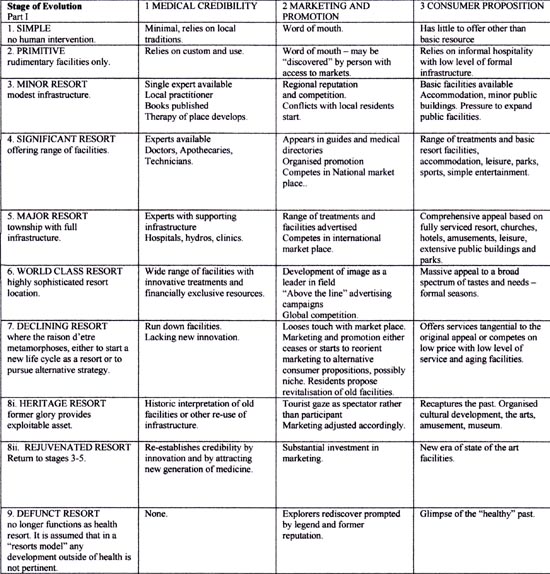
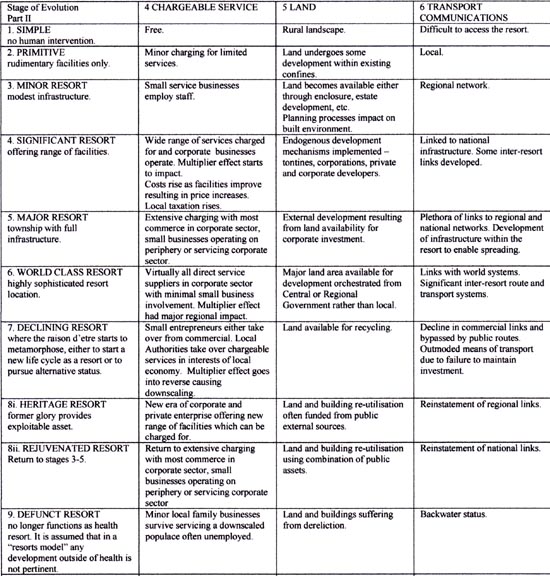
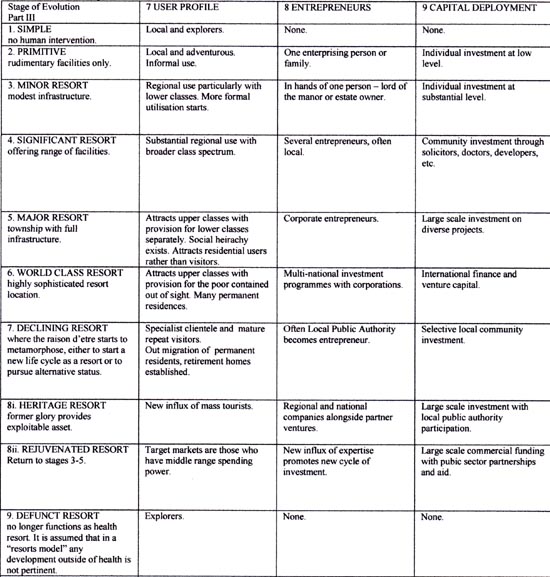
Click on website below to return to Index and Introduction.
Website: Click Here
SUPPLEMENTARY INFORMATION
1) TOPOGRAPHICAL LOCATION:
England
3) INFORMATION CATEGORY:
Springs and Wells General InterestHistory & Heritage


